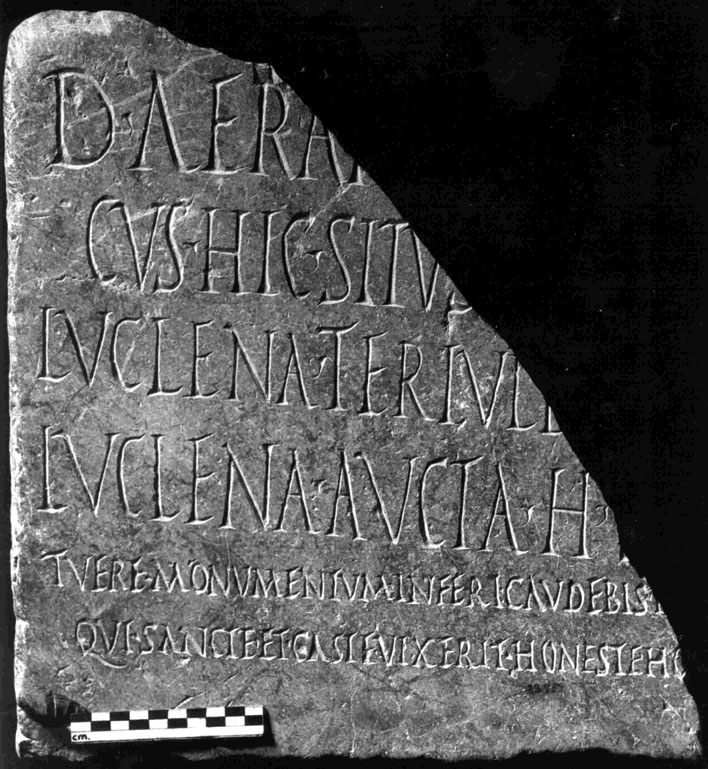Epitaph of Decimus Aerarius
Reference CIL II2/ 7, 402 | Description | Lyrics | Location | Chronology | Epigraphic edition | Translation | Apparatus | Comentary | Type of verse | Text divided into verses and metric signs | Images | Bibliography | Link to DB | Author |
Epitaph of Decimus Aerarius
Description
- Idno filename 22/01/0073
- Type of inscription: Sepulcralis
- Support: Tablet
- Material: Limestone Material Description: Grey marble.
- Conservation status: Fragmented. The left half is preserved. Rough sides.
- Dimensions height/width/depth (cm): 41/36/8.5
-
Epigraphic field:
- Layout: No border on the epigraphical field. Good ordinatio although in general the text slants slightly downwards on the right-hand side.Interpunctions after each word: hederae in ll. 1-4 and triangles with the vertices pointing downwards in ll. 5-6. Indentation in lines 2 and 6 to align the text around a central axis.
- Preserved
Lyrics
- Font:Capital cuadrada
- Description of the letters:Capital book script decreasing in the carmen (ll. 5- 6). Good deep cutting.Horizontal crossbar of the T curving upwards at the end of the stroke. The three horizontal strokes of the E are slighly curved. The Q has a long horizontal tail. Following gaudebis in l. 5 the lower part of the vertical crossbar of a letter, perhaps H, can be seen.
Location
- Place of discovery: Found in 1979 at Calle Conde Godomar number 13, Córdoba.
- Geolocation
- Conservation location: Exhibited in room III of the MAP in Córdoba.
- Inventory number: 28935
- Location with Modern Nomenclature España / Córdoba
- Location with Old Nomenclature Hispania / Baetica / Cordubensis / Corduba
Chronology
- Inscription's dating: The year 0
- Dating explanation: 2nd c. AD from the form of the letters and the formulae it contains (Stylow).
Type of verse
- Type of verse: Yámbico (senario)
- Verse/line correspondence: Si
- Prose/verse distinction: Si
Epigraphic edition
D(ecimus) ▴ Aerar[ius ‑ ‑ ‑]-
cus ▴ hic ▴ situs [est ‑ ‑ ‑]
Luclena ▴ Tertull[a h(ic) s(ita) e(st)]
Luclena▴ Aucta ▴ h(ic) ▴ s(ita) [e(st)]
5 tuere ▴ monumentum ▴ inferi ▴ ˹g˺audebis ▴ h[oc]
qui ▴ sancte ▴ et ▴ caste ▴ vixerit ▴ honeste ▴ ho[mo]
Text divided into verses and metric signs
Tuere monumentum inferi gaudebis [hoc], kl|kkk|l/l|kl|ll|k[~]
qui sancte et caste vixerit honeste homo. ll|ll|l/l|kl|kl|k~
Translation
“Decimus Aerarius (…) is buried here. Luclena Tertula is buried here. Luclena Aucta is buried here. Protect the funerary monument; you will enjoy the afterlife (…) Who lived honestly and modestly as an honourable man”.
Bibliography
Stylow, CIL II2/7, 402 cum im. phot.; Cugusi 2012, 24; Hernández Pérez 20172017a, 96-99. – Cf. Hernández Pérez 2001a, 148, 151 et 153 adn. 625 (inde HEp 2001, 259); id. 2002, 67-68; Carande 2010, 232 (HEp 2010, 123). Post gaudebis in v. 5 lineae verticalis ima pars perspicitur, quae fortasse litterae H initium est.
Apparatus
1–6 supp. Stylow. – 2 supplendum fortasse s. t. t. l. Stylow. – 5 h[oc]suppl. Hernández Pérez in diss. et Carande, i[d] malit Hernández Pérez 2017; [hoc] contulit J. A. Correa; caudebis in lapide; ‘g’audebis · +[ ] Stylow; 6 ho[mo] suppl. Hernández Pérez in diss., ho[minibus] Cugusi contra metrum, ho[—] Stylow.
Comentary
Funerary inscription to three deceased. Praescriptum in prose (ll. 1-4). Carmen
in iambic senarii in ll. 5-6. Apparent verse-line correspondence. Usual topoi for this
type of composition: appeal to the passer-by to protect the grave (tuere monumentum
gaudebis); laudatio funebris with adverbs which recall the good conduct of the
deceased (sancte, caste, honeste). Similar parallels in, among others, vixi quod potui
sem/per bene pauper honeste (CLE 991 and CLE 992) and honestam uitam vixsit / pius
et splendidus / ut sibi quisque exoptet / se honeste vivere (CLE 70).
The nomen Luclena is rare in Hispania. Nevertheless, it is found in another two
inscriptions, also from Córdoba (Luclena CIL II27 405 and Lucleno CIL II25 323 = CIL
II 1621).
Author
- Author:M. Limón Belén
- Last Update2024-02-07 16:36:37
- Autopsy date:2010
You can download this






